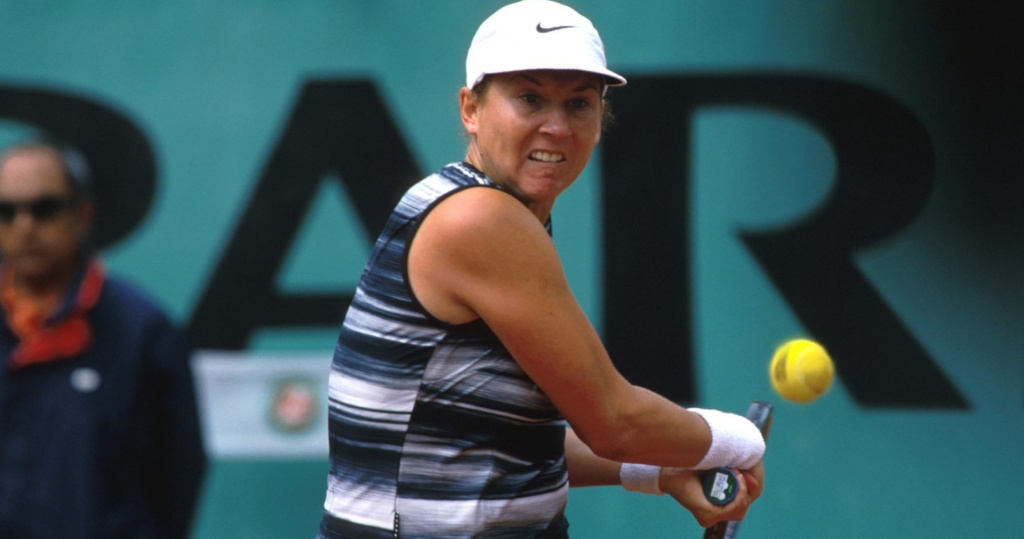April 18, 1999: The day Monica Seles helped USA beat Croatia in Fed Cup
Each day, Tennis Majors looks back at the biggest moments in tennis history. On April 18, 1999, Yugoslavia-born Monica Seles helped the USA win a Fed Cup tie against Croatia.
 Monica Seles, On This Day
Monica Seles, On This Day
What happened exactly on that day
On this day, April 18, 1999, Monica Seles, who was born in the former Yugoslavia but who had become a US citizen in 1994, defeated Iva Majoli 6-0, 6-3, to clinch a Fed Cup against Croatia, a former Yugoslavian state. This match was played in a particularly tense context: the tie had been originally scheduled to be played in Zagreb, but, due the NATO bombing of Yugoslavia at the time, it had to be moved to the United States.



The players: Monica Seles and Iva Majoli
- Monica Seles – nine-time major champion
Monica Seles had been one of the most successful players in the world at a particularly young age. Her powerful two-handed groundstrokes, her innovative way of hitting the ball so early with so much power, and of course her trademark grunting, represented an absolute revolution in the women’s game. In 1989, she played her first full year on the tour and, after claiming her first title at spring in Houston, she played her first Grand Slam main draw at Roland-Garros.
This first appearance in Paris would be long remembered. In the third round, facing world No 4 Zina Garrison, young Monica, aged 15, gave away flowers to the Centre Court public before crushing her opponent 6-3, 6-2. She went on to the semi-final where she was only defeated in three sets (6-3, 3-6, 6-3) by the then-unbeatable Steffi Graf, who had won the last five Grand Slam tournaments. In 1990, at the age of 16, she was the youngest ever player to win Roland-Garros.
It was the start of her domination on the tour. In March 1991, aged 17, she became the youngest world No 1 in tennis history, knocking Graf from the throne she had been sitting on since the summer of 1987. From January 1991, Seles won seven of the eight Grand Slam tournaments she participated in, losing only the 1992 Wimbledon final, setting a 56-1 victory-loss record. Furthermore, she claimed three WTA Finals titles in a row in 1990, 1991 and 1992.

Her career was brutally interrupted on April, 30, 1993, in the quarter-finals of the Hamburg Open, when she was stabbed at a changeover by a mentally unstable Graf fan. The psychological wound proved to be much deeper than the knife-blow itself. Although she was physically ready to play just a few months afterwards, it would take over two years before she played on the tour again, while she became a US citizen in 1994. She came back under the spotlight in the summer of 1995, winning her first tournament, in Toronto (defeating Amanda Coetzer, 6-1, 6-0).
A few weeks later, she finished runner-up at the US Open (lost to Graf, 7-6, 0-6, 6-3). At the start of 1996, aged 22, she won her last Grand Slam tournament at the Australian Open. In the final, she defeated Anke Huber, from Germany (6-4, 6-1). Since then, she remained a top 10 player, but, suffering with food disorders and weight issues that she would later describe in her book, she never lifted a Grand Slam trophy again. She still reached the final round twice, at the US Open 1996 (defeated by Graf, 7-5, 6-4) and at Roland-Garros 1998 (defeated by Sanchez, 7-6, 0-6, 6-2). In April 1999, she was world No 4.
- Iva Majoli – 1997 Roland-Garros champion
Iva Majoli, from Croatia, born in 1977, broke into the top 100 in 1992, the year she made her Grand Slam debut at the US Open, where she made her way to the second round. In 1993, she reached the Roland-Garros fourth round (lost to Inés Gorrochategui, 7-5, 6-4), and in 1994, she played her first finals on the Tour, in Osaka, Barcelona and Essen, finishing the year as world No 13.
In 1995, she claimed her first title in Zurich (defeating Mary Pierce in the final, 6-4, 6-4), followed by a second one on the following week, in Filderstadt (defeating Gabriela Sabatini, 6-4, 7-6), and at the end of the season, she was world No 9. Her career peaked in 1997, when, to general astonishment, she triumphed at Roland-Garros, defeating Martina Hingis in the final (6-4, 6-2). In April 1999, she was world No 32.

The place: Raleigh, North Carolina
The Fed Cup tie between the United States and Croatia was originally supposed to be held in Zagreb, but as war was still raging in the former Yugoslavia at the time, it was decided to play on American soil, in Raleigh, North Carolina. The Raleigh Racquet Club’s main court could host 2,500 spectators and tickets for the Fed Cup tie were sold out far in advance.
The facts: mixed emotions for Seles
In April 1999, when the United States Fed Cup team was to face Croatia, Monica Seles experienced mixed emotions. Born Yugoslavian, in Novi Sad, Serbia, she became an American citizen in 1994. She became a member of the American Fed Cup team, and so far, she had never been defeated in the competition. She was usually keen to play, but this time, she was hesitant to travel to Zagreb to play against other Yugoslavian-born players, who, a few years ago, would have been part of her team.
However, at the time, NATO was bombing the former Yugoslavia and it was decided that the tie was going to be held in the United States. In this political context, playing against Croatia was not an easy decision to make for the former world No 1. On top of that, many members of the Croatian delegation were old friends of her father, Karolj, who had passed away in 1998. Once the tie was relocated to Raleigh, Seles confirmed her participation.
“We see each other as friends, as tennis players; we’re not the politicians,” Seles said.
On the opening day, Chanda Rubin edged Iva Majoli (7-6, 4-6, 10-8), and Seles swept Silvija Talaja off the court (6-3, 6-1). In the third match, Seles, facing Majoli, had the opportunity to clinch the title. Both players were Yugoslavs at birth, but this was no reason for Seles to show any mercy to her opponent. In only 43 minutes, she destroyed the 1997 Roland-Garros champion, who hadn’t fully recovered from the marathon she had lost the day before (6-0, 6-3). “It was more like her playing perfect and I could do nothing,” Majoli said. “I always seem to produce the best tennis for Fed Cup, and I’m really focused,” Seles commented.
What happened next: Seles gets bronze in 2000 Olympics
In the following round of the 1999 Fed Cup, Monica Seles would be defeated for the first time, by Silvia Farina (6-4, 4-6, 6-4), but with the support of the Williams sisters, the United States would make their way to the title, defeating Russia in the final (4-1).
In 2000, she would obtain her last remarkable result, at the Sydney Olympics, where she would obtain the bronze medal. Struggling with a foot injury, she would play her last match ever at Roland-Garros in 2003, which she would lose against Nadia Petrova (6-4 6-0), although she would only announce her official retirement in 2008.









